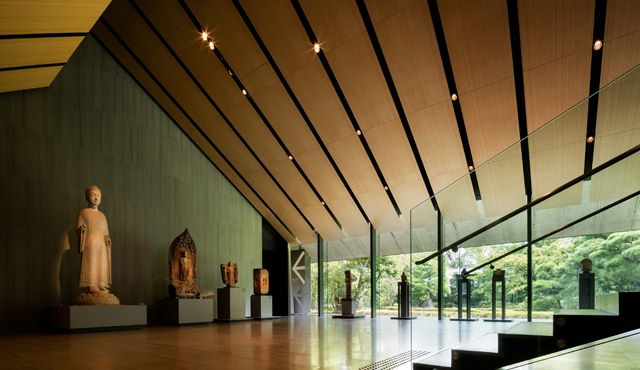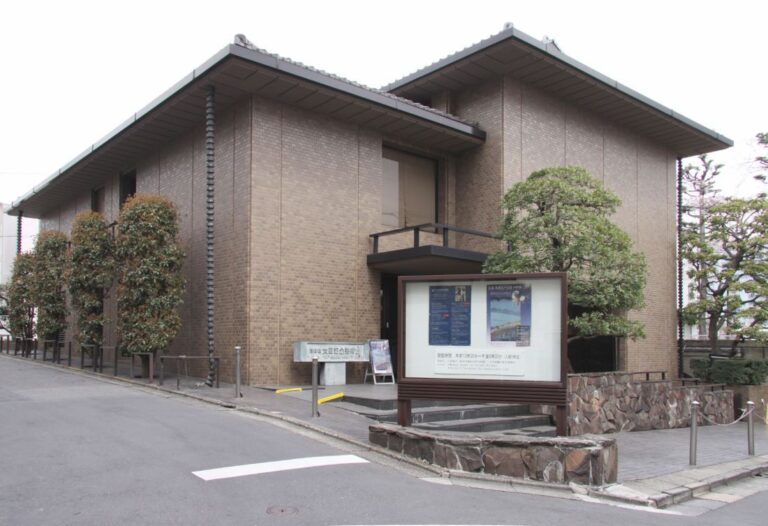The Nezu Museum is a cultural institution in the Minami-aoyama district of Tokyo that houses a vast collection of Japanese and Asian premodern art. The museum was founded in 1941 by Nezu Kaichiro, a prominent businessman and art collector, who bequeathed his collection of over 7,400 works of art to the public.

The museum has since expanded its collection through acquisitions and donations, and now boasts an impressive array of paintings, sculptures, ceramics, textiles, and other artifacts that span over 2,000 years of history.
Collections

The museum’s permanent collection includes over 7,400 works, including paintings, calligraphy, sculpture, ceramics, textiles, metalwork, and lacquerware.
The collection is based on the bequest of Nezu Kaichiro, a businessman and art collector who passed away in 1940. Nezu Kaichiro’s collection was originally housed in his private residence, which was designed by the architect Kengo Kuma and opened to the public as the Nezu Museum in 2009.
The Nezu Museum’s collection is organized into categories, including:
- Buddhist art
- Tea ceremony art
- Chinese art
- Korean art
- Japanese art
One of the highlights of the collection is the museum’s extensive collection of tea ceremony utensils, which includes over 900 items. The collection includes tea bowls, tea caddies, water jars, and other utensils used in the Japanese tea ceremony.
Another notable area of the collection is the museum’s collection of Chinese bronzes, which includes over 300 items. The collection includes ritual vessels, mirrors, and other objects dating from the Shang to the Han dynasties.
The Nezu Museum’s collection of Japanese art includes works from the Heian to the Edo periods, including paintings, calligraphy, sculpture, and ceramics. Notable works include a pair of six-panel folding screens by Kano Tanyu and a set of twelve hanging scrolls by Soga Shohaku.
Exhibitions

The collection includes paintings, calligraphy, ceramics, metalwork, textiles, and sculptures.
The exhibitions at the Nezu Museum change regularly, offering visitors the opportunity to see different aspects of Japanese and Asian art. The museum showcases both permanent and temporary exhibitions. The permanent exhibition features works from the Nezu collection, while the temporary exhibitions showcase works from other collections around the world.
The museum also has a beautiful garden that you can explore. The garden was designed by Nezu Kaichiro himself and features a pond, a tea house, and plants and trees. The garden is a perfect place to relax and enjoy the beauty of nature.
| Current Exhibitions | Date |
|---|---|
| Masterpieces of Japanese Art from the Nezu Museum and the Tokyo National Museum | March 19 – June 12, 2023 |
| The Art of Tea | June 17 – September 18, 2023 |
| Japanese Ceramics from the Nezu Museum Collection | September 23 – December 25, 2023 |
check the museum’s website for the latest information on exhibitions and events. The Nezu Museum is a popular destination , so it’s best to plan your visit in advance to avoid crowds.
Overall, the Nezu Museum is a cultural and scenic highlight of Tokyo’s fashionable Aoyama district. The museum offers exhibitions and events that showcase the beauty and diversity of Japanese and Asian art.
Architecture and Gardens

The Nezu Museum is a stunning example of contemporary Japanese architecture, designed by Kengo Kuma & Associates. The museum’s design is inspired by traditional Japanese architecture, with a focus on natural materials and the use of light and shadow to create a sense of harmony and tranquility.
One of the standout features of the Nezu Museum is its beautiful garden, which covers over 17,000 square meters and is home to over 1,000 trees and plants. The garden is designed to reflect the changing seasons, with cherry blossoms in the spring, lush greenery in the summer, and vibrant autumn foliage in the fall.
You can explore the garden at their leisure, taking in the tranquil ponds, winding paths, and carefully tended landscapes. The garden is also home to historic buildings, including a teahouse and a shrine, which provide a glimpse into Japan’s rich cultural heritage.

Inside the museum, you can admire the stunning collection of art and artifacts, which includes everything from ancient pottery and textiles to contemporary paintings and sculptures. The museum’s galleries are designed to showcase the art in a way that complements the architecture and garden, creating a seamless and immersive experience for visitors.
Overall, the Nezu Museum is a must-see destination for anyone interested in Japanese art, architecture, and culture. Whether you’re a local or a visitor from overseas, the museum’s stunning design and beautiful gardens are sure to leave a lasting impression.
Visitor Information

If you’re heading to Tokyo, the Nezu Museum is a great destination for art lovers and history buffs. Here’s some important information to help you plan your visit.
Location and Hours
The Nezu Museum is in the Minami-aoyama district of Tokyo. The address is 6-5-1 Minami-aoyama, Minato-ku, Tokyo 107-0062. The museum is open from 10:00 am to 5:00 pm, with last admission at 4:30 pm. The museum is closed on Mondays, but is open on national holidays that fall on a Monday, and is closed the following day instead.
Admission and Tickets
Admission to the Nezu Museum is 1,300 yen for adults, 1,100 yen for college and high school students, and free for children and junior high school students. There are also discounts available for seniors and groups of 20 or more. Tickets can be purchased at the museum or online in advance. check the museum’s website for any special exhibitions or events that may affect admission prices or availability.
Amenities

The Nezu Museum offers amenities to make your visit more comfortable. There is a gift shop where you can purchase souvenirs and books related to the museum’s collection. There are also restrooms and coin-operated lockers available for visitors. The museum is wheelchair accessible, and strollers are available for rent for visitors with young children.
Guided Tours
You can explore the museum on their own, but guided tours are also available in English and Japanese. The tours are free with admission, but require advance reservation. The museum also offers audio guides in English, Japanese, Chinese, and Korean for a fee of 500 yen.
History
The Nezu Museum has a rich history that dates back to the early 20th century. It was founded by Nezu Kaichiro, a successful entrepreneur and politician, who began collecting pre-modern Japanese and East Asian art in the late 19th century. Over the years, his collection grew to include over 7,000 pieces, ranging from paintings and calligraphy to ceramics and sculptures.
In 1940, Nezu Kaichiro passed away, and his collection was inherited by his son, Nezu Yasuhei. Yasuhei continued to add to the collection and opened the museum to the public in 1941. Unfortunately, the museum was severely damaged during World War II, and most of the collection was lost. However, Yasuhei was determined to rebuild the museum, and he spent the next years acquiring new pieces and restoring the old ones.
In 1946, the Nezu Museum reopened its doors to the public, and it has been a beloved institution ever since. Over the years, the museum has undergone renovations and expansions, including a major renovation in 2006 by the renowned architect Kengo Kuma. Today, the Nezu Museum is considered one of the finest museums in Tokyo, and it continues to attract visitors from all over the world.






